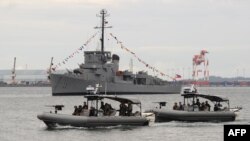MANILA —
Philippine officials say they will begin formal talks with the United States Wednesday on having more frequent U.S. military visits as part of a plan to deter China from infringing on what Manila claims is its territory in the South China Sea.
Officials say having the U.S. presence would mean more joint military exercises and equipment ready for use at Philippine bases. They say this would help support the country’s “minimum credible defense” posture.
Philippine officials say they want to see the increased rotations begin before 2016, when President Benigno Aquino leaves office.
While the Philippine military is undergoing a modernization program, its spending still lags some of the smallest defense budgets in the region.
The Philippines was host to U.S. bases for nearly 100 years until domestic pressure forced them to close in 1991.
Carl Baker, program director at the Washington-based Center for Strategic and International Studies, said this time around public opposition is “dramatically reduced.”
“And the people who are supportive of it are significantly increased and probably more politically motivated, given what China has been doing,” Baker said.
Baker pointed to encounters such as China’s presence at Scarborough Shoal, the site of a tense standoff last year between Philippine and Chinese ships over alleged poaching by Chinese fishermen in waters claimed by the Philippines. The Philippines backed off and Chinese vessels remained at the shoal where Philippine fishermen said they were rebuffed.
The Philippines lost nearby Mischief Reef to China in the mid-1990s. In May, officials said a Chinese frigate and some of its surveillance ships were near Second Thomas Shoal, also in Philippine-claimed waters.
China claimed it has “indisputable sovereignty” over much of the resource-rich South China Sea. The Philippines, Vietnam, Taiwan, Malaysia and Brunei have whole or partial claims to it.
The Philippines $1.8 billion military spending plan is going toward new hardware including 12 fighter jets, two frigates and an air-surveillance radar. This week it took official delivery of a second Hamilton-class cutter from the U.S. collection of used assets. Officials say working the increased U.S. visits into this program will give its strategy a needed boost.
Although there now appears to be public support for the increased U.S. military visits, Baker said that could easily change because it will be difficult for the U.S. to meet the Philippines’ expectations.
“What they’re going to have a difficult time demonstrating is their willingness to actually deliver defense of those areas because it gets back to the old argument from the United States," he explained. " What exactly is the United States committed to defend? And that’s the detail where the strategic message gets a little bit hazy.”
The two countries signed a mutual defense treaty in 1951, which calls on each nation to defend the other in certain kinds of attacks. However, the United States maintains its neutrality on the territorial disputes in the South China Sea, saying it is an issue for the countries in the region to resolve.










